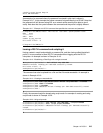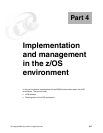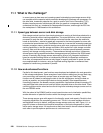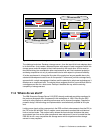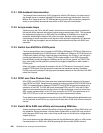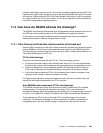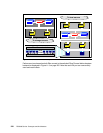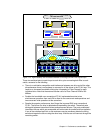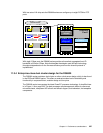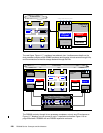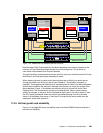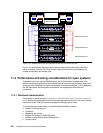Chapter 11. Performance considerations 223
relatively small logical volumes, we ran out of device numbers to address an entire LSS. This
happens even earlier when configuring not only real devices (3390B) within an LSS, but also
alias devices (3390A) within an LSS in z/OS environments. By the way, an LSS is congruent
to an logical control unit (LCU) in this context. An LCU is only relevant in z/OS and the term is
not used for open systems operating systems.
11.3 How does the DS6000 address the challenge?
The DS6000 overcomes the architectural limits and bottlenecks which developed over time in
the ESS due to the increasing number of I/Os and MB/sec from application servers.
In this section we go through the different layers and discuss how they have changed to
address performance in terms of throughput and I/O rates.
11.3.1 Fibre Channel switched disk interconnection at the back end
Because SSA connectivity has not been further enhanced to increase the connectivity speed
beyond 40MB/sec, Fibre Channel connected disks were chosen for the DS6000 back end.
This technology is commonly used to connect a group of disks in a daisy-chained fashion in a
Fibre Channel Arbitrated Loop (FC-AL).
FC-AL shortcomings
There are some shortcomings with plain FC-AL. The most obvious ones are:
As the term arbitration implies, each individual disk within an FC-AL loop competes with
the other disks to get on the loop because the loop supports only one operation at a time.
Another challenge which is not adequately solved is the handling of failures within the
FC-AL loop, particularly with intermittently failing components on the loops and disks.
A third issue with conventional FC-AL is the increasing time it takes to complete a loop
operation as the number of devices increases in the loop.
For highly parallel operations, concurrent reads and writes with various transfer sizes, this
impacts the total effective bandwidth of an FC-AL structure.
How DS6000 series overcomes FC-AL shortcomings
The DS6000 uses the same Fibre Channel drives as used in conventional FC-AL-based
storage systems. To overcome the arbitration issue within FC-AL, the architecture is
enhanced by adding a switch-based approach and creating FC-AL switched loops, as shown
in Figure 11-2 on page 224. Actually it is called a Fibre Channel switched disk subsystem.
These switches use FC-AL protocol and attach FC-AL drives through a point-to-point
connection. The arbitration message of a drive is captured in the switch, processed and
propagated back to the drive, without routing it through all the other drives in the loop.



